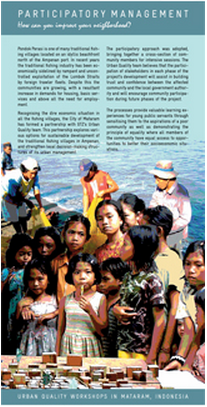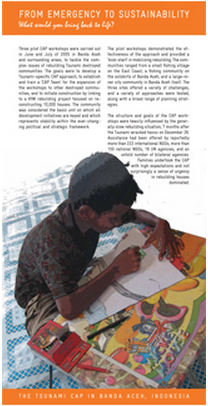Interactive Community Planning
Community planning is much easier with printed charts, graphics, or checklists that can help gather support for a project. The main common choice for planning is called participatory methods or planning. Participatory methods are designed to build self-esteem and a sense of responsibility for one’s decisions. They are designed for planning at community level and can be useful for identifying positive and negative behaviours related to hygiene. Participants learn from each other and develop respect for each other’s knowledge and skills. A participatory approach brings together representatives of all the local stakeholders.
Contents
Getting Started: Interactive Community Planning
There are three levels of information included: An overview of four main types, a more detailed description of each of the main types, and a detailed, step-by-step example from South Africa of how to carry out an interactive workshop.
Examples of three interactive workshops illustrate different goals, but all follow the approach. All involve the community as active development partners.
Reload the image links below in case it doesn't work the first time.

|

|

|
Overview of Participatory Planning Approaches
Four families of participatory community planning are reviewed. Note that there are also other variations of these basic four.
- Community Action Planning or MicroPlanning developed by Hamdi and Goethert
- Planning for Real developed by Tony Gibson and the Neighborhood Initiatives Foundation
- ZOPP (or GOPP in English: Goal Oriented Project Planning) championed by the German Agency for Technical Cooperation (GTZ)
- Urban Community Assistance Team (UCAT) developed from the American Institute of Architecture’s U/DAT approach in the US
- They are problem-driven. Their procedures are defined to respond to problems encountered on site. Actual problems as well as perceived problems are considered.
- They offer a ranked order of priority. Problems and issues are prioritized to a manageable few which can be undertaken within available resources. Innovation comes from the creative ways in which projects are designed and implemented.
- They are pluralistic. They value partnerships between community and outsider, in all stages of project development. Their interactive techniques strive to further this end and they invite differences of opinion which encourage dialogue and creative solutions.
- They strive for a process which is transparent and understandable.
- They stress progressive documentation of process and results as a means with which to promote learning and encourage follow-up.
- All use an intensive workshop format as their primary modality.
- Their focus is implementation. Projects and programs, rather than study or research is the goal.
Acknowledgements
- Interactive Community Planning. MIT, GTZ, The World Bank Group.

